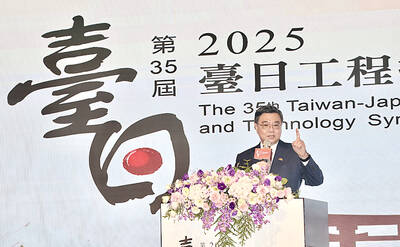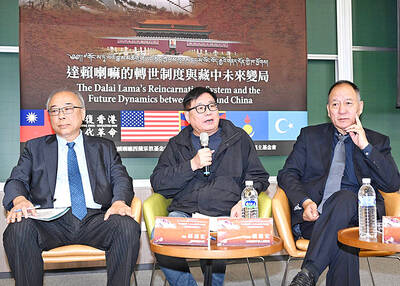Too little effort has been made in Taiwan to research the role the country played in the Pacific Theater of World War II, wasting an opportunity to establish wartime history from a Taiwanese perspective, academics said at a seminar yesterday.
“There are many relics, preserved or faded away, and stories, told or untold, in Taiwan that preserve the memory of war, but most people often talk about World War II like it happened elsewhere,” National Chengchi University historian Tai Pao-tsun (戴寶村) said at the seminar, which was focused on history in Taiwan between 1941 and 1949.
Nine theses were discussed at the seminar, which was organized by Taiwan Extra-Patriot Veterans Association (TEPVA) for the second consecutive year and is aimed at promoting academic research on the nation’s recent war history.
Many of the thesis authors, including Tai, lamented that most of the information cited in their studies came from either the US or Japan — a result of Taiwan’s inadequate preservation of relics, documents and oral history as well as the education system implemented by the Chinese Nationalist Party (KMT) government after it took over Taiwan.
If not for these reasons, it would be hard to explain why some young people today would think that it was Japan, rather than the US, that bombed Taiwan during the war and why few are aware that the Presidential Office building, known at the time as the Office of the Governor-General, suffered a direct hit and extensive damage in a bombing raid in Taipei in 1945, they said.
Tai and Tu Cheng-yu (杜正宇), a doctoral candidate of history at National Cheng Kung University, said conducting more research into Taiwan’s history during the period would help people understand more about the nation’s role and strategic significance in the war, as well as Taiwanese’s lives during the Japanese colonial period.
The authors intended to demonstrate the value of more research by covering a wide range of topics in the seminar, including the US’ bombing of the Okayama Airfield — now known as Gangshan (岡山), Kaohsiung — Japan’s deployment of special attack speed boats in Taiwan and Penghu, the recruitment of student soldiers in 1945, Japan’s invasion of the islands in the South China Sea, as well as the KMT government’s recruitment and kidnapping of Taiwanese to be soldiers to fight in the Chinese Civil War.
According to statistics from the Japanese Ministry of Health, Labor and Welfare, more than 30,000 Taiwanese soldiers were killed in the Pacific War, 15,000 of whom are listed as missing in action.
Hundreds of thousand of Taiwanese were directly or indirectly involved in the war, said Lee Hsueh-feng (李雪峰), who was among 8,000 Taiwanese boys between the ages of 12 and 14 who went to Yamato City in Japan’s Kanagawa Prefecture in 1943 to build fighter planes.
More than 300 of those boys died during the Allied bombing of Japan and never returned home, Lee said, adding that the more one knows about war, the more he or she understands that peace should be cherished.
The period between 1943 and 1949 for Taiwanese was probably so unique that it would never be replicated again, Lee said.
“Some of us fought for Japan, some for the KMT and some for the Chinese Communist Party. And some did more than one,” Lee said.

ALIGNED THINKING: Taiwan and Japan have a mutual interest in trade, culture and engineering, and can work together for stability, Cho Jung-tai said Taiwan and Japan are two like-minded countries willing to work together to form a “safety barrier” in the Indo-Pacific region, Premier Cho Jung-tai (卓榮泰) yesterday said at the opening ceremony of the 35th Taiwan-Japan Modern Engineering and Technology Symposium in Taipei. Taiwan and Japan are close geographically and closer emotionally, he added. Citing the overflowing of a barrier lake in the Mataian River (馬太鞍溪) in September, Cho said the submersible water level sensors given by Japan during the disaster helped Taiwan monitor the lake’s water levels more accurately. Japan also provided a lot of vaccines early in the outbreak of the COVID-19 pandemic,

Kaohsiung Mayor Chen Chi-mai (陳其邁) on Monday announced light shows and themed traffic lights to welcome fans of South Korean pop group Twice to the port city. The group is to play Kaohsiung on Saturday as part of its “This Is For” world tour. It would be the group’s first performance in Taiwan since its debut 10 years ago. The all-female group consists of five South Koreans, three Japanese and Tainan’s Chou Tzu-yu (周子瑜), the first Taiwan-born and raised member of a South Korean girl group. To promote the group’s arrival, the city has been holding a series of events, including a pop-up

TEMPORAL/SPIRITUAL: Beijing’s claim that the next Buddhist leader must come from China is a heavy-handed political maneuver that will fall flat-faced, experts said China’s requirement that the Dalai Lama’s reincarnation to be born in China and approved by Beijing has drawn criticism, with experts at a forum in Taipei yesterday saying that if Beijing were to put forth its own Dalai Lama, the person would not be recognized by the Tibetan Buddhist community. The experts made a remarks at the two-day forum hosted by the Tibet Religious Foundation of His Holiness the Dalai Lama titled: “The Snow Land Forum: Finding Common Ground on Tibet.” China says it has the right to determine the Dalai Lama’s reincarnation, as it claims sovereignty over Tibet since ancient times,

Temperatures in some parts of Taiwan are expected to fall sharply to lows of 15°C later this week as seasonal northeasterly winds strengthen, the Central Weather Administration (CWA) said today. It is to be the strongest cold wave to affect northern Taiwan this autumn, while Chiayi County in the southwest and some parts of central Taiwan are likely to also see lower temperatures due to radiational cooling, which occurs under conditions of clear skies, light winds and dry weather, the CWA said. Across Taiwan, temperatures are to fall gradually this week, dropping to 15°C to 16°C in the early hours of Wednesday